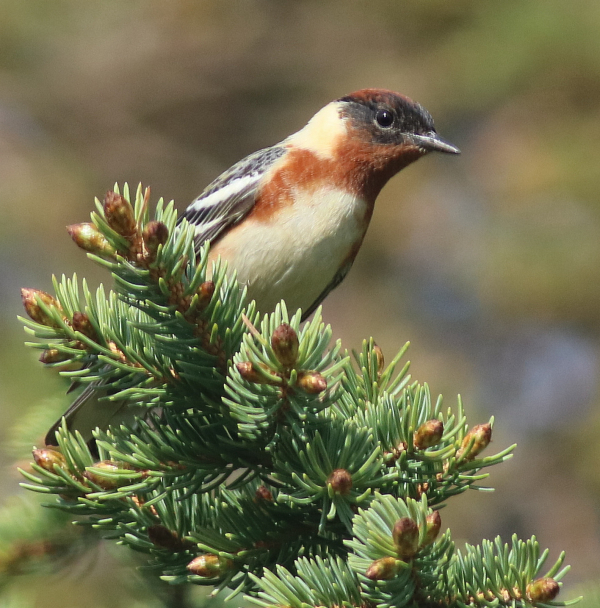
Most ducks, like this pair of Northern Shovelers, undertake medium-distance migrations that include important stopover feeding sites (photos by Paul Konrad).

Many songbirds undertake long-distance migrations, like this Bay-breasted Warbler that migrated between the species nesting range in the boreal forests of Canada to winter somewhere from Costa Rica to northern Columbia, or one of the larger islands of Caribbean.
|
More than half of the 650-plus species of birds that nest in North American are migratory. Birds migrate to move from areas of low or decreasing food to areas of high or increasing resources. The 3 primary resources they search for are food, water, and nesting locations. Birds that nest in the Northern Hemisphere tend to migrate northward in the spring to take advantage of burgeoning insect populations, budding and flowering plants, and an abundance of nesting sites.
Primarily during late summer and fall, as the availability of insects and other foods are reduced, birds move south again. Escaping the cold is a motivating factor but many species, even hummingbirds, can withstand a below freezing temperature as long as an adequate supply of quality food is available.
Types of Migration
The term migration describes periodic, large-scale movements of populations of animals. One way to look at migration is to consider the distances traveled:
Short-distance Migrants make relatively short movements, such as from higher to lower elevations in a mountain range.
Medium-distance Migrants cover distances that span a few hundred miles, or a little more.
Long-distance Migrants typically move from nesting ranges in the United States and Canada to wintering range in Central America or areas of South America. Despite the arduous journeys involved, long-distance migration is a feature of about 350 species of North American birds.
The pattern of migration can vary within each of the above categories, but it is most variable among short-distance and medium-distance migrants.
Origins of Long-Distance Migration
While short-distance migration probably developed from a fairly simple need for food, the origins of long-distant migration patterns are much more complex. They’ve evolved over thousands of years and are controlled at least partly by the genetic make-up of the birds. The origins also resulted in response to weather, geography, food sources, day length, and other factors.
For birds that winter in the tropics, it seems strange to imagine leaving that region to embark on a long migration north. Why make such an arduous trip north during spring? One theory is that through many generations the tropical ancestors of these birds dispersed from their tropical nesting sites northward. The seasonal abundance of insect foods and a longer daylight period during spring and summer allowed them to raise more nestlings (4 to 6 on average) than their non-migratory tropical relatives (2 to 3 average). As their nesting zones moved north during periods of glacial retreat, the birds continued to return to their tropical range as winter weather and declining food supplies made survival more difficult. Supporting this theory is the fact that most North American warblers, orioles, vireos, tanagers, flycatchers, and swallows have evolved from ancestral birds that originated in the tropics.
What Triggers Migration?
The mechanisms initiating migratory behavior vary and are not always completely understood. Migration can be triggered by a combination of changes in day length, cooler temperatures, changes in food supplies, and genetic predisposition. Different species of birds and even segments of populations within the same species may follow different migratory patterns.
How Do Birds Navigate?
Migrating birds can cover thousands of miles during their annual flights, often traveling the same course year after year with little deviation. First-year birds often make their very first migration south on their own. Somehow they can find their winter range despite never having experienced the migration or seeing the winter location before. Then, they return to their nesting range the following spring, which may even be close to where they fledged.
The secrets of the amazing navigational skills of birds aren’t fully understood, partly because birds combine several different types of senses when they navigate. Birds can get compass information from the sun and stars, and by sensing the earth’s magnetic field. They also get information from the position of the setting sun and from landmarks seen during the day. There’s even some evidence that sense of smell plays a role for some birds.
Some species, particularly waterfowl and cranes, follow preferred migration routes annually that are often tied to important stopover locations that provide food that’s critical to the birds’ survival during migration. Smaller birds tend to migrate in broad fronts across the landscape. Studies using eBird data have revealed that many birds take different migration routes during spring and fall to take advantage of seasonal patterns in weather and food at varied locations along the way.
In short, migration is an interesting subject with a lot of variation among species, populations, and individuals. For a bit more information provided at the end of the original All About Birds article published by the Cornell Lab of Ornithology, see https://www.allaboutbirds.org/news/the-basics-how-why-and-where-of-bird-migration/